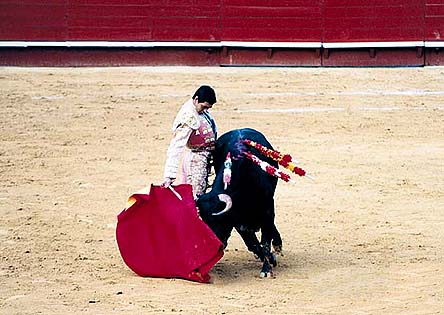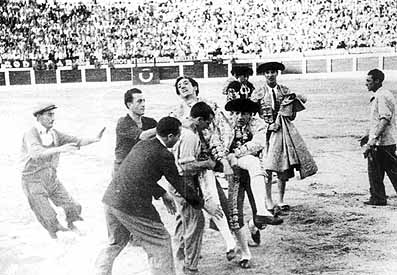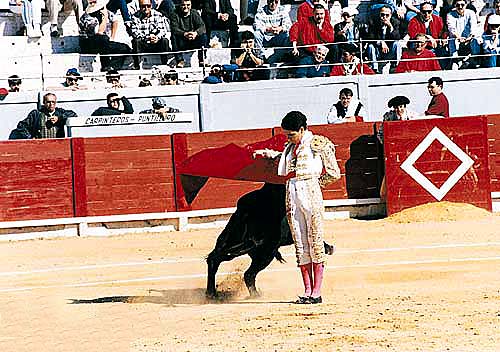F O L K E T I B I L D / K U L T U R F R O N T 7/97
f o r a l l a f i c i o n a d o s


Vicente Barrera, one of todays great toreros, with a natural in the
Manolete stile. Photo: Ricardo
Manolete - myth and legend
"Manolete", alias, Manuel Rodriguez Sanchez is
one of Spain's most legendary bullfighters. He was born in the city of Cordoba
in July 1917.

 Thirty years later, when he was at
the zenith of his career, he met his death on the horns of the bull "Islero".
This year, the fiftieth anniversary of his death, which occurred on 28th
August in the town of Linares, will be commemorated.
Thirty years later, when he was at
the zenith of his career, he met his death on the horns of the bull "Islero".
This year, the fiftieth anniversary of his death, which occurred on 28th
August in the town of Linares, will be commemorated.
Text and photographs by Ricardo Delgado
and Francisco Caño
Translation by Andrea
Taylor
In a way, it was strange that he should meet his
fate on the horns of one of the dreaded Miura bulls in a small town in
Andalusia like Linares, in the province of Jaen. Many of the greatest
bullfighters have met their death in small villages when, ironically, most of
them take their greatest risks in the big, more important rings in Spain.
However, death often creeps up on them unawares when they are least expecting
it.

 Manolete's earnings on that tragic
afternoon were 300,000 pesetas - an unbelievable sum in 1947, and even more
incredible in a small provincial town like Linares. But Manolete was second to
none; in a class of his own. Undoubtedly, he was the biggest star in the
Spanish bullfight cosmos at the time. He was rated as The Best. He took his
alternativa in Seville in July 1939, right at the end of the Spanish civil
war, and at the age of 29, he already commented that he was thinking of
quitting the business and going into retirement. "I have already earned more
money than five generations of my ancestors all together," he said. "But I
have never really had time to enjoy the money. I'm planning to quit the ring
while I'm still all in one piece."
Manolete's earnings on that tragic
afternoon were 300,000 pesetas - an unbelievable sum in 1947, and even more
incredible in a small provincial town like Linares. But Manolete was second to
none; in a class of his own. Undoubtedly, he was the biggest star in the
Spanish bullfight cosmos at the time. He was rated as The Best. He took his
alternativa in Seville in July 1939, right at the end of the Spanish civil
war, and at the age of 29, he already commented that he was thinking of
quitting the business and going into retirement. "I have already earned more
money than five generations of my ancestors all together," he said. "But I
have never really had time to enjoy the money. I'm planning to quit the ring
while I'm still all in one piece."

 Antonita Lupe Sino, actress, and
his long-time girlfriend, did not agree. "They'll never let him go until they
see him dead," she said, referring to the public. Manolete was slim, almost
anorexic-looking by today's standards, and this was said to be the result of
his extremely poor childhood. If you see photographs and films of him, he
always appears with that tragic, mournful expression; he was a true Don
Quixote, dressed in a suit of lights. This, together with his very personal
and special way of fighting bulls, (he always stood tall, erect, and with his
body close to the beast) and his unique repertoire in the ring, made him stand
out from all the others - an idol, whose style is still copied by young
bullfighters today.
Antonita Lupe Sino, actress, and
his long-time girlfriend, did not agree. "They'll never let him go until they
see him dead," she said, referring to the public. Manolete was slim, almost
anorexic-looking by today's standards, and this was said to be the result of
his extremely poor childhood. If you see photographs and films of him, he
always appears with that tragic, mournful expression; he was a true Don
Quixote, dressed in a suit of lights. This, together with his very personal
and special way of fighting bulls, (he always stood tall, erect, and with his
body close to the beast) and his unique repertoire in the ring, made him stand
out from all the others - an idol, whose style is still copied by young
bullfighters today.

 In February 1946, he inaugurated
the new Plaza Mexico, in Mexico City DC., the largest bullfighting arena in
the world. This arena had, in fact, been built for his sake, as a direct
result of the fever he had created among the Mexican aficionados the previous
season. This arena has a capacity of 55,000 spectators and here, Manolete
would receive the largest fee ever paid to a bullfighter so far; 200,000
pesos. Manolete used to pay 1,000 pesetas a day to his banderilleros - a sum
which is around double the pay which banderilleros receive today in
comparative terms. He imported a Buick from the USA, a car which needed
special petrol not available in Spain, where the fuel at that time was more
suited to tractors and agricultural machinery!!
In February 1946, he inaugurated
the new Plaza Mexico, in Mexico City DC., the largest bullfighting arena in
the world. This arena had, in fact, been built for his sake, as a direct
result of the fever he had created among the Mexican aficionados the previous
season. This arena has a capacity of 55,000 spectators and here, Manolete
would receive the largest fee ever paid to a bullfighter so far; 200,000
pesos. Manolete used to pay 1,000 pesetas a day to his banderilleros - a sum
which is around double the pay which banderilleros receive today in
comparative terms. He imported a Buick from the USA, a car which needed
special petrol not available in Spain, where the fuel at that time was more
suited to tractors and agricultural machinery!!

 Barnaby Conrad, the well-known
American writer and amateur bullfighter, who followed Manolete in South
America, wrote once : "The machinery was beginning to wear out. Even though he
was only 29, he looked like a man of 40. He was drinking a lot, and the
precision of his fighting began to wane. I remember once, in Peru, when he
needed to give nine descabellos to kill his bull. Tears were pouring down his
face as he left the ring."
Barnaby Conrad, the well-known
American writer and amateur bullfighter, who followed Manolete in South
America, wrote once : "The machinery was beginning to wear out. Even though he
was only 29, he looked like a man of 40. He was drinking a lot, and the
precision of his fighting began to wane. I remember once, in Peru, when he
needed to give nine descabellos to kill his bull. Tears were pouring down his
face as he left the ring."

 Manolete met his tragic death with
his last bull in Linares. It happened as he went in for the kill; the "moment
of truth" as the Spanish say. He threw himself over the horns, disregarding
the danger, instead of taking the easy way out as so many bullfighters do by
feinting to one side. The sword was already in up to the hilt, when the bull
hooked his mighty head sideways and plunged his terrible horns deep into the
torero's groin, tossing him into the air. The beast tried repeatedly to gore
the wounded man on the ground until it staggered to it's knees and fell down
dead.
Manolete met his tragic death with
his last bull in Linares. It happened as he went in for the kill; the "moment
of truth" as the Spanish say. He threw himself over the horns, disregarding
the danger, instead of taking the easy way out as so many bullfighters do by
feinting to one side. The sword was already in up to the hilt, when the bull
hooked his mighty head sideways and plunged his terrible horns deep into the
torero's groin, tossing him into the air. The beast tried repeatedly to gore
the wounded man on the ground until it staggered to it's knees and fell down
dead.


The death of Manolete. Guillermo, his sword-handler [L], with his
hand against the
wound trying to stop the blood. Luis Miguel
Dominguin [R], with capa. Photo:
Caño |
During this very bullfight, the light of a new bullfighting star began to
shine; Luis Miguel Dominguin. He pronounced himself "Numero Uno" - the Number
One - shortly after Manolete's death. Dominguin was a hearthrob and fond of
provoking public opinion. One of his brothers was a self-proclaimed communist,
and this had not passed unnoticed by General Franco himself. The General once
asked Dominguin whether it was true that he had a communist for a brother, and
Luis Miguel's witty reply was "In our family, we are all communists!" His
romances were numerous, and much publicised. Ava Gardner, Lauren Bacall, Romy
Schneider, Rita Hayworth and Brigitte Bardot were just a few of his conquests.
He belonged to the the select group of foreign intellectuals including Ernest
Hemingway, Orson Welles, Picasso, Cocteau and Luis Bunuel. Dominguin actually
financed the latter's film production "Viridiana".

 Manolete used to say to José
Camará, his manager, that he would give his best in all rings; even the
smaller ones, because according to "El Monstruo" as he was known, the public
were paying the same money to see him, wherever he fought. As we can see in
the photograph, he did not die immediately following then goring; but his
tretament in the bullring infirmary, much criticised and argued about ever
since, was deficient, and he passed away in the early hours of the following
morning. Many bullfighters meet their death precisely because of the very
primitive and basic first aid that they are given after a goring, rather than
from the type of wound itself.
Manolete used to say to José
Camará, his manager, that he would give his best in all rings; even the
smaller ones, because according to "El Monstruo" as he was known, the public
were paying the same money to see him, wherever he fought. As we can see in
the photograph, he did not die immediately following then goring; but his
tretament in the bullring infirmary, much criticised and argued about ever
since, was deficient, and he passed away in the early hours of the following
morning. Many bullfighters meet their death precisely because of the very
primitive and basic first aid that they are given after a goring, rather than
from the type of wound itself.

 Guillermo, Manolete's faithful
sword-handler, said after the tragic event, that he would never step into a
bullring again - and he kept his promise, for he never did.
Guillermo, Manolete's faithful
sword-handler, said after the tragic event, that he would never step into a
bullring again - and he kept his promise, for he never did.

 Manolete is buried in his native
town of Cordoba, and in this city, you can also visit the famous bullfight
museum, where you can see a number of relics of the "Monstruo" and other
famous Cordoban bullfighting stars. During this 50th. anniversary of
Manolete's death, many special commemorative acts will be taking place all
over Spain in his honour. Since his death, Manolete has had many imitators;
but not one of them has been capable of living up to one of the greatest
legends ever to wear the suit of lights.
Manolete is buried in his native
town of Cordoba, and in this city, you can also visit the famous bullfight
museum, where you can see a number of relics of the "Monstruo" and other
famous Cordoban bullfighting stars. During this 50th. anniversary of
Manolete's death, many special commemorative acts will be taking place all
over Spain in his honour. Since his death, Manolete has had many imitators;
but not one of them has been capable of living up to one of the greatest
legends ever to wear the suit of lights.

Jose Tomás, a contemporary torero, walking in Manoletes footsteps.
Foto: Ricardo


F O L K E T I B I L D / K U L T U R F R O N T 7/95


Cover & Index

![]()

![]()
![]() Manolete used to say to José
Camará, his manager, that he would give his best in all rings; even the
smaller ones, because according to "El Monstruo" as he was known, the public
were paying the same money to see him, wherever he fought. As we can see in
the photograph, he did not die immediately following then goring; but his
tretament in the bullring infirmary, much criticised and argued about ever
since, was deficient, and he passed away in the early hours of the following
morning. Many bullfighters meet their death precisely because of the very
primitive and basic first aid that they are given after a goring, rather than
from the type of wound itself.
Manolete used to say to José
Camará, his manager, that he would give his best in all rings; even the
smaller ones, because according to "El Monstruo" as he was known, the public
were paying the same money to see him, wherever he fought. As we can see in
the photograph, he did not die immediately following then goring; but his
tretament in the bullring infirmary, much criticised and argued about ever
since, was deficient, and he passed away in the early hours of the following
morning. Many bullfighters meet their death precisely because of the very
primitive and basic first aid that they are given after a goring, rather than
from the type of wound itself.![]()
![]() Guillermo, Manolete's faithful
sword-handler, said after the tragic event, that he would never step into a
bullring again - and he kept his promise, for he never did.
Guillermo, Manolete's faithful
sword-handler, said after the tragic event, that he would never step into a
bullring again - and he kept his promise, for he never did.![]()
![]() Manolete is buried in his native
town of Cordoba, and in this city, you can also visit the famous bullfight
museum, where you can see a number of relics of the "Monstruo" and other
famous Cordoban bullfighting stars. During this 50th. anniversary of
Manolete's death, many special commemorative acts will be taking place all
over Spain in his honour. Since his death, Manolete has had many imitators;
but not one of them has been capable of living up to one of the greatest
legends ever to wear the suit of lights.
Manolete is buried in his native
town of Cordoba, and in this city, you can also visit the famous bullfight
museum, where you can see a number of relics of the "Monstruo" and other
famous Cordoban bullfighting stars. During this 50th. anniversary of
Manolete's death, many special commemorative acts will be taking place all
over Spain in his honour. Since his death, Manolete has had many imitators;
but not one of them has been capable of living up to one of the greatest
legends ever to wear the suit of lights.